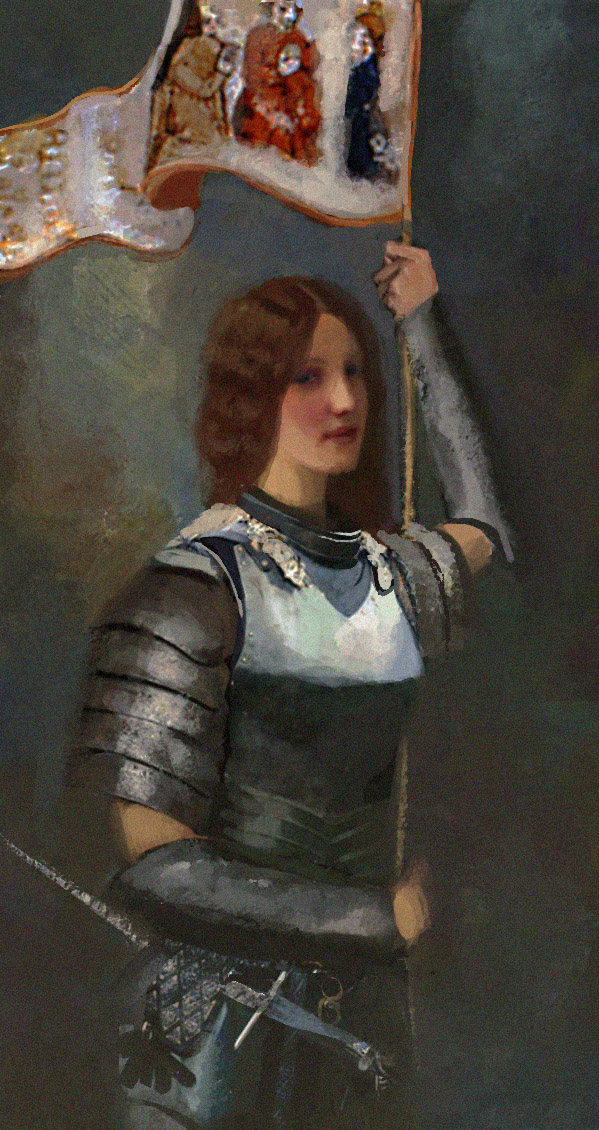Joan of Arc
Joan of Arc (1412 – 30 May 1431), who called herself "Joan the Maiden" ("Jehanne la Pucelle" in 15th-century French) and is now nicknamed "The Maid of Orléans," is considered a heroine of France for her role during the Lancastrian phase of the Hundred Years' War. She was convicted and burnt at the stake as a heretic, but her conviction was later overturned.

She is a saint in the Roman Catholic Church.
Early life
Joan of Arc was born sometime around 1412 in Domrémy, a small village in the Meuse valley, which is now located in the Vosges department within the historical region of Lorraine, France. Her parents were Jacques d'Arc and Isabelle Romée. Joan had at least three brothers and a sister; all but one of the brothers was older. Her father was a peasant farmer of some means. The family had about 50 acres (20 ha) of land, and her father supplemented the family income with a minor position as a village official, collecting taxes and heading the local watch.
Visions
In 1425, Joan had her first vision. She saw a figure she identified as Saint Michael surrounded by angels appeared to her in her father's garden. After the vision, she reported weeping because she wanted them to take her with them. Throughout her life, she continued to have visions of Saint Michael, as well as Saint Catherine and Saint Margaret. In 1428, a young man from her village took her to court on the allegation that she had broken a promise of marriage, which was brought before the local bishop in the city of Toul. The bishop dismissed the suit after ruling in her favor.
In 1428, she traveled to Vaucouleurs and requested to be taken to Charles VII of France, later testifying that she had received visions from Archangel Michael, Saint Margaret, and Saint Catherine instructing her to support Charles and recover France from English domination. Her request to see the king was rejected twice, but eventually the garrison commander Robert de Baudricourt relented and gave her an escort to meet Charles at Chinon.
Career as a Soldier
After their interview, Charles sent Joan, who was about 17 years old, to the siege of Orléans as part of a relief army. She arrived at the city on 29 April 1429, and quickly gained prominence for her role in the fighting. The siege was lifted nine days after her arrival. In June, Joan played a key role in the Loire Campaign, which culminated in the decisive defeat of the English at the Battle of Patay. The French army advanced on Reims and entered the city on 16 July. The next day, Charles was consecrated as the King of France in Reims Cathedral with Joan at his side. These victories boosted French morale and paved the way for the final French victory in the Hundred Years' War at Castillon in 1453.
After Charles' consecration, Joan and John II, Duke of Alençon's army besieged Paris. An assault on the city was launched on 8 September. It failed, and Joan was wounded. The French army withdrew and was disbanded. In October, Joan was participating in an attack on the territory of Perrinet Gressart, a mercenary who had been in the service of the English and their French allies, the Burgundians. After some initial successes, the campaign ended in a failed attempt to take Gressart's stronghold at La-Charité-sur-Loire. Joan was back at the French court at the end of the year, where she learned that she and her family had been ennobled by Charles.
Capture and trial
In early 1430, Joan organized a company of volunteers to relieve Compiègne, which had been besieged by the Burgundians. She was captured by Burgundians troops on 23 May and exchanged to the English.
She was put on trial by the pro-English bishop, Pierre Cauchon, on a charge of heresy. She was declared guilty and burned at the stake on 30 May 1431, dying at about 19 years of age.
Veneration
In 1456, Pope Callixtus III authorized an inquisitorial court to investigate the original trial. The court nullified the trial's verdict, declaring it was tainted by deceit and procedural errors, and Joan was exonerated.
Since her death, Joan has been popularly revered as a martyr. After the French Revolution she became a national symbol of France. She was canonized on May 16th, 1920, and declared a secondary patron saint of France in 1922.
In the Afro-Brazilian religion of Candomblé, Joan of Arc is syncretized with the orixá Obá, a fierce warrior who protects justice.
In popular culture
Joan of Arc remains a popular figure in literature, painting, sculpture and music.